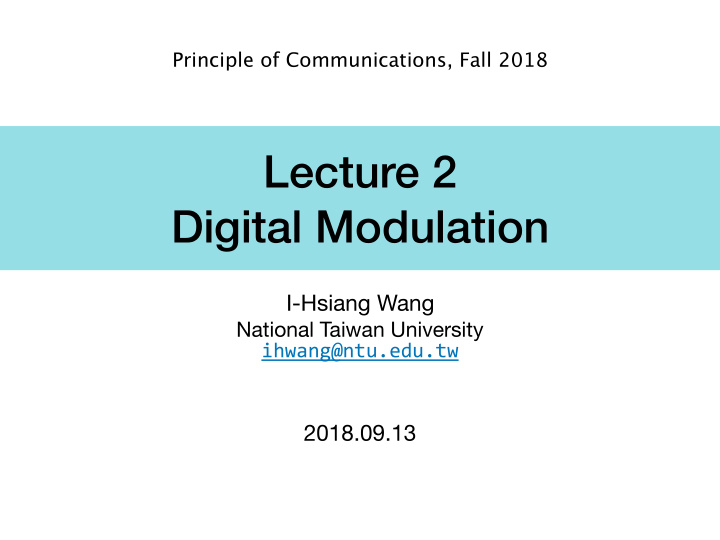



Principle of Communications, Fall 2018 Lecture 2 Digital Modulation I-Hsiang Wang National Taiwan University ihwang@ntu.edu.tw 2018.09.13
Outline • Digital-to-analog & analog-to-digital: a signal space view • Pulse amplitude modulation (PAM) • Pulse shaping and the Nyquist criterion • Quadrature amplitude modulation (QAM) • The equivalent complex baseband representation • Symbol mapping and constellation set � 2
Architecture of Digital Modulation x ( t ) Symbol Pulse Up { u m } x b ( t ) { c i } Mapper Shaper Converter discrete baseband passband coded bits Noisy sequence waveform waveform Channel y ( t ) Symbol Filter + Down { ˆ u m } y b ( t ) { ˆ c i } Demapper Sampler Converter • Three major components at Tx: ‣ Symbol mapping: bit sequence → symbol sequence ‣ Pulse shaping: symbol sequence → (baseband) waveform ‣ Up conversion: baseband waveform → passband waveform • Corresponding components at Rx: ‣ Symbol demapping ‣ Filter + Sampling ‣ Down conversion � 3
Bit-to-Symbol Mapping x ( t ) Symbol Pulse Up { u m } x b ( t ) { c i } Mapper Shaper Converter discrete baseband passband coded bits Noisy sequence waveform waveform Channel y ( t ) Symbol Filter + Down { ˆ u m } y b ( t ) { ˆ c i } Demapper Sampler Converter • To be designed in this layer: ‣ constellation set – collection of all possible symbols ‣ symbol mapping – how to map bits to symbols • In this lecture, we introduce ‣ Constellation: standard PSK, standard PAM, standard QAM ‣ Mapping: Gray mapping • Key system parameter: rate � 4
Sequence-to-Waveform x ( t ) Symbol Pulse Up { u m } x b ( t ) { c i } Mapper Shaper Converter discrete baseband passband coded bits Noisy sequence waveform waveform Channel y ( t ) Symbol Filter + Down { ˆ u m } y b ( t ) { ˆ c i } Demapper Sampler Converter • Most pragmatic: Pulse Amplitude Modulation (PAM) • To be designed in this layer: ‣ the modulating pulse + the receiver filter • Nyquist criterion: a su ffi cient condition for the pulse to satisfy in order to avoid aliasing e ff ect • Key system parameter: bandwidth � 5
Baseband-to-Passband x ( t ) Symbol Pulse Up { u m } x b ( t ) { c i } Mapper Shaper Converter discrete baseband passband coded bits Noisy sequence waveform waveform Channel y ( t ) Symbol Filter + Down { ˆ u m } y b ( t ) { ˆ c i } Demapper Sampler Converter • Most pragmatic: Quadrature Amplitude Modulation (QAM) ‣ Essentially speaking, PAM with two branches: ‣ one mixed with cosine, the other with sine • Equivalent complex baseband representation • Key system parameter: center frequency � 6
Part I. Signal Space A linear algebraic view for the conversion between sequences and waveforms 2018.09.13 � 7
Recommend
More recommend